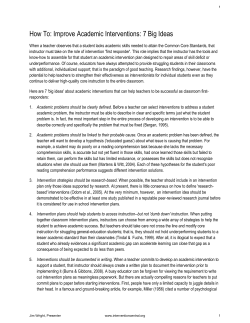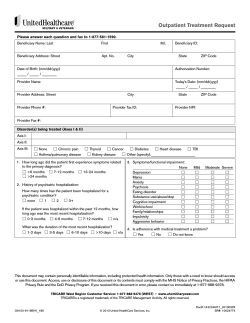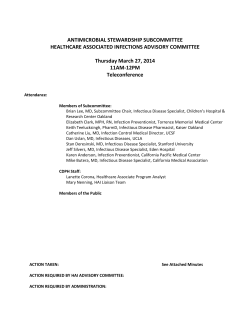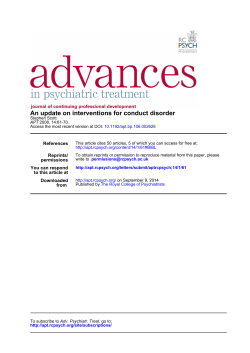
Behaviour Change Strategies to Influence Antimicrobial Prescribing in Acute Care Hospitalière
Behaviour Change Strategies to Influence Antimicrobial Prescribing in Acute Care Congrès National de la Société Française d'Hygiène Hospitalière Paris 2013 Esmita Charani e.charani@imperial.ac.uk Research Objectives: Understand the cultural and contextual influences that shape HCW behaviours in acute care settings Understand how these behaviours impact on Infection Prevention and Control (IP&C) and prudent antimicrobial prescribing outcomes Develop multimodal behaviour change interventions that will consider barriers and facilitators to behaviour change Evaluate behaviour change interventions and their impact on infection outcomes What’s missing? • Necessary to understand the factors that influence prescribing behaviour and decisions • Address human factors • Adopt a whole-system approach to support optimal prescribing choices. • Supporting choice architecture. Decision architecture…. Charani et al JAC 2010 • Guidelines and policy developed to help decision making • These provide knowledge and awareness BUT….. They may not shift attitudes and change practice • The goal should be to make prudent prescribing the default and routine practice • Do we need to investigate habitual behaviour as a first step to changing it? • ‘Mindlines not guidelines Gabbay ,Le May 2004 BMJ 329 Recognise Factors affecting behaviour : • Personal, Social, Environmental Policies and guidelines are not enough…. J Carthey et al BMJ 2011; 343 Social Construct of Prescribing A social process Under influence of many determinants Collateral impact not tangible at prescriber/ patient level Theories of behaviour change considered? Many theories out there No definition in healthcare • Behavioral interventions: Developing systems that address human factors (decision aids, desired action is the default, habits and patterns used in design, process clearly specified, takes advantage of pathways). • Rear R 2006 HSR 41.4,1677-89, Pronovost et al HSR 41:4 1599-1617 Nudge -R Thaler and C Sunstein Pronovost- ‘’critical information for doctors was not being presented in a format that is easy for the brain to retrieve in critical situations………’’ • Behavioural Economics… • Behavioral interventions: Developing systems that address human factors (decision aids, desired action is the default, habits and patterns used in design, process clearly specified, takes advantage of pathways). • Rear R 2006 HSR 41.4,1677-89, Pronovost et al HSR 41:4 1599-1617 Nudge -R Thaler and C Sunstein Pronovost- ‘’critical information for doctors was not being presented in a format that is easy for the brain to retrieve in critical situations………’’ • Behavioural Economics… • • • Behaviour change a key element of optimising antibiotic prescribing Systematic reviews to date do not assess behaviour change An expanded approach to systematic review methodology developed – Inclusion of both qualitative and quantitative literature (1999-2009) (E. Charani et al CID 2011) – Expanding and Integrating Quality Criteria for Systematic Review of Multiple Study Designs within Healthcare: The ICROMS Tool: it builds on criteria established in the literature: The Cochrane Risk of Bias Tool for randomised controlled trials; The EPOC (Effective Practice and Organisation of Care) criteria for controlled and non-controlled before-and-after and controlled and noncontrolled interrupted time series; Epidemiology studies (Gordis 2000) for prospective cohort studies; CASP (Critical Appraisal Skills Program) for qualitative studies (Edwards, Drumright, Secci, Sevdalis, & Holmes, under review) • • • Behaviour change a key element of optimising antibiotic prescribing Systematic reviews to date do not assess behaviour change An expanded approach to systematic review methodology developed – Inclusion of both qualitative and quantitative literature (1999-2009) (E. Charani et al CID 2011) – Expanding and Integrating Quality Criteria for Systematic Review of Multiple Study Designs within Healthcare: The ICROMS Tool: it builds on criteria established in the literature: The Cochrane Risk of Bias Tool for randomised controlled trials; The EPOC (Effective Practice and Organisation of Care) criteria for controlled and non-controlled before-and-after and controlled and noncontrolled interrupted time series; Epidemiology studies (Gordis 2000) for prospective cohort studies; CASP (Critical Appraisal Skills Program) for qualitative studies (Edwards, Drumright, Secci, Sevdalis, & Holmes, under review) Charani E et al Behavior Change Strategies to Influence Antibiotic Prescribing in Acute Care: A Systematic Review. CID, October 2011;53(7):651–662 Findings.. • Interventions to optimize antimicrobial prescribing behaviour are of poor quality and are not based on robust theoretical science. • Behaviour and social science research is underutilized in the development of antimicrobial prescribing interventions. • Qualitative evidence highlights the influence of social norms, attitudes, and beliefs on antimicrobial prescribing behaviour • When designing and evaluating interventions in antimicrobial prescribing, these influences on prescribing are generally not considered. •These findings stress the need for multidisciplinary research to investigate the utilization of behavioural and social sciences to assess prescribing behaviour and set standards. •The lack of this approach may be a contributing factor to the challenges that beset interventions aiming to influence prescribing behaviour and optimize antimicrobial prescribing. Need a different approach to interventions? •Work with healthcare professionals to improve the choice environment •Environment of shared knowledge •Recommended Elements of an Intervention to Target Behavioural Change in Antibx Prescribing Charani et al CID 2011 Findings echoed in IPC Psychological and social marketing frameworks are applied in qualitative studies, but rarely in intervention studies 1. Experiential and habitual nature of IPC behaviours: cannot be addressed as rational processes by interventions 2. Need to take into account social and cultural factors that affect behaviour in the design, implementation and reporting of interventions 3. Need to target the intervention to segmented groups of HCWs Edwards R et al. Optimisation of infection prevention and control in acute health care by behaviour change: a systematic review. TLID 2012 Feb16 Addressing Antibiotic Stewardship as an organisational change issue need to consider : • Issues and agendas: Political science concept of a crowded decision making agenda; • Power and influence: Specialists and generalists, Who ‘owns’ antibiotic stewardship? Coalition building needs? • Governance framework • Roles and relationships: difficult move from a narrow technical role to a broader strategic role, coalition of supporters • Organisational culture and learning • Supporting Knowledge bases E Ferlie.et al 2003 British Journal of Management, 14, S1: S1-14. Qualitative Research Face to face semi-structured interviews with 39 healthcare staff across four hospitals Interviews conducted by experienced researchers Deductive and inductive approach in analysis Open coding used to identify relevant categories Weekly meetings to discuss the data and emerging themes Prevention of dilution of analysis by pre-specified conceptual models Inter-rater reliability between 85-100% Final themes agree to by all three researchers Multidisciplinary approach has primarily included: • Infectious Disease Physicians • Clinical Microbiologists • Clinical or Infectious Disease Pharmacists • Epidemiologist • At times, infection prevention and control teams Can nurses contribute to antimicrobial stewardship? Supporting Organisational Structures and Systems 1) Structures, lines of responsibility and high-level notification to the Board. 2) Operational delivery of an antimicrobial strategy- with operational standards of good antimicrobial stewardship. 3) Risk assessment for antimicrobial chemotherapy. 4) Clinical governance assurance 5) Education and training 6) Antimicrobial pharmacist -with systems in place for ensuring optimum use. 7) Patients, Carers and the Public-address information needs Caution- Monitor unintended Consequences • Must ensure patients receive early effective treatment and prompt care not compromised. • Should build in balances/checks, mechanisms to mitigate and monitor potential unintended consequences, poorly treated infections etc • Deliver on the Surviving sepsis care bundle(Obtain blood cultures prior to antibiotic administration and administer broad-spectrum antibiotic, within 3 hrs of A&E admission) – yet ensure subsequent de-escalation • Improved monitoring of clinical outcomes In summary Interventions need to be guided by hypothesis Better understanding of the determinants of antimicrobial prescribing Needs to be out into the social context No gold standard stewardship model Successful interventions need to be based on theories Need to construct theories that are Generalisable Achievable Evidence-based
© Copyright 2025





















